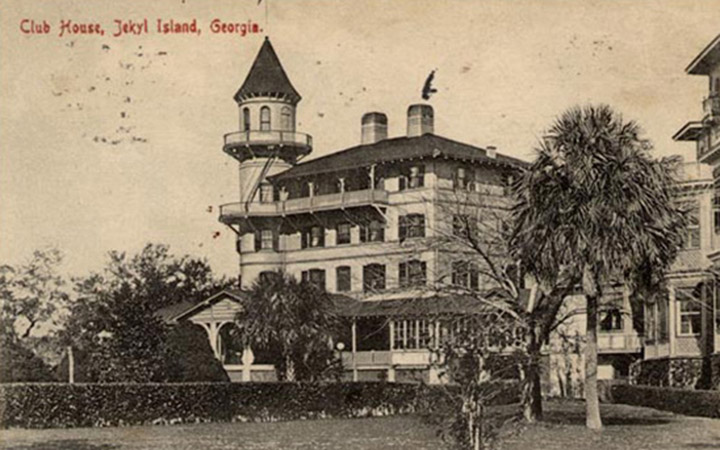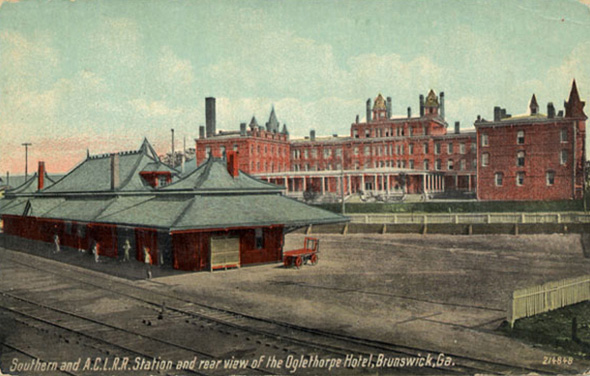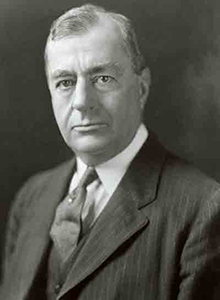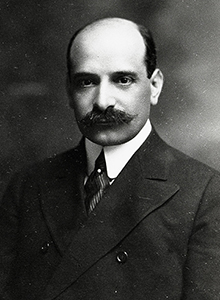The Meeting at Jekyll Island
November 20, 1910-November 30, 1910

In November 1910, six men—Nelson Aldrich, A. Piatt Andrew, Henry Davison, Arthur Shelton, Frank Vanderlip and Paul Warburg—met at the Jekyll Island Club, off the coast of Georgia, to write a plan to reform the nation's banking system. The meeting and its purpose were closely guarded secrets, and participants did not admit that the meeting occurred until the 1930s. But the plan written on Jekyll Island laid a foundation for what would eventually be the Federal Reserve System.
The Need for Reform
At the time, the men who met on Jekyll Island believed the banking system suffered from serious problems. The Jekyll Island participants' views on this issue are well known, since before and after their conclave several spoke publicly and others published extensively on the topic. Collectively, they encapsulated their concerns in the plan they wrote on Jekyll Island and in the reports of the National Monetary Commission.
Like many Americans, these men were concerned with financial panics, which had disrupted economic activity in the United States periodically during the nineteenth century. Nationwide panics occurred on average every fifteen years. These panics forced financial institutions to suspend operations, triggering long and deep recessions. American banks held large required reserves of cash, but these reserves were scattered throughout the nation, held in the vaults of thousands of banks or as deposits in financial institutions in designated reserve and central reserve cities. During crises, they became frozen in place, preventing them from being used to alleviate the situation. During booms, banks' excess reserves tended to flow toward big cities, especially New York, where bankers invested them in call loans, which were loans repayable on demand to brokers. The brokers in turn loaned the funds to investors speculating in equity markets, whose stock purchases served as collateral for the transactions. This American system made bank reserves immobile and equity markets volatile, a recipe for financial instability.
In Europe, in contrast, bankers invested much of their portfolio in short-term loans to merchants and manufacturers. This commercial paper directly financed commerce and industry while providing banks with assets that they could quickly convert to cash during a crisis. These loans remained liquid for several reasons. First, borrowers paid financial institutions—typically banks with which they had long-standing relationships—to guarantee repayment in case the borrowers could not meet their financial obligations. Second, the loans funded merchandise in the process of production and sale and that merchandise served as collateral should borrowers default. The Jekyll Island participants also worried about the inelastic supply of currency in the United States. The value of the dollar was linked to gold, and the quantity of currency available was linked to the supply of a special series of federal government bonds. The supply of currency neither expanded nor contracted with seasonal changes in demands for cash, such as the fall harvest or the holiday shopping season, causing interest rates to vary substantially from one month to the next. The inelastic supply of currency and limited supplies of gold also contributed to long and painful deflations.
Furthermore, Jekyll Island participants believed that an array of antiquated arrangements impeded America's financial and economic progress. For example, American banks could not operate overseas. Thus, American merchants had to finance imports and exports through financial houses in Europe, principally London. American banks also struggled to collectively clear checks outside the boundaries of a single city. This increased costs of inter-city and interstate commerce and required risky and expensive remittances of cash over long distances.
In an article published in the New York Times in 1907, Paul Warburg, a successful, German-born financier who was a partner at the investment bank Kuhn, Loeb, and Co. and widely regarded as an expert on the banking systems in the United States and Europe, wrote that the United States' financial system was "at about the same point that had been reached by Europe at the time of the Medicis, and by Asia, in all likelihood, at the time of Hammurabi" (Warburg 1907).
Just months after Warburg wrote those words, the country was struck by the Panic of 1907. The panic galvanized the US Congress, particularly Republican senator Nelson Aldrich, the chair of the Senate Finance Committee. In 1908, Aldrich sponsored a bill with Republican representative Edward Vreeland that, among other things, created the National Monetary Commission to study reforms to the financial system. Aldrich quickly hired several advisers to the commission, including Henry Davison, a partner at J.P. Morgan, and A. Piatt Andrew, an economics professor at Harvard University. Over the next two years, they studied banking and financial systems extensively and visited Europe to meet with bankers and central bankers.
The Duck Hunt
By the fall of 1910, Aldrich was persuaded of the necessity of a central bank for the United States. With Congress ready to begin meeting in just a few weeks, Aldrich—most likely at Davison's suggestion—decided to convene a small group to help him synthesize all he had learned and write down a proposal to establish a central bank.
The group included Aldrich; his private secretary Arthur Shelton; Davison; Andrew (who by 1910 had been appointed assistant Treasury secretary); Frank Vanderlip, president of National City Bank and a former Treasury official; and Warburg.
A member of the exclusive Jekyll Island Club, most likely J.P. Morgan, arranged for the group to use the club's facilities. Founded in 1886, the club's membership boasted elites such as Morgan, Marshall Field, and William Kissam Vanderbilt I, whose mansion-sized "cottages" dotted the island. Munsey's Magazine described it in 1904 as "the richest, the most exclusive, the most inaccessible" club in the world.

Aldrich and Davison chose the attendees for their expertise, but Aldrich knew their ties to Wall Street could arouse suspicion about their motives and threaten the bill's political passage. So he went to great lengths to keep the meeting secret, adopting the ruse of a duck hunting trip and instructing the men to come one at a time to a train terminal in New Jersey, where they could board his private train car. Once aboard, the men used only first names—Nelson, Harry, Frank, Paul, Piatt, and Arthur—to prevent the staff from learning their identities. For decades after, the group referred to themselves as the "First Name Club."
An additional member of the First Name Club was Benjamin Strong, vice president of the Bankers Trust Company and the future founding chief executive officer (then called governor, now called president) of the Federal Reserve Bank of New York. But it is unlikely Strong attended the meeting on Jekyll Island. In his autobiography, Vanderlip recalls him attending, but no other account indicates Strong's presence. Most scholars and journalists who have written about the issue, including Bertie Charles (B.C.) Forbes—the founder of Forbes magazine and the journalist who first revealed the meetings in an article in 1916—have concluded Strong did not attend (Forbes 1916). Strong had worked closely with the Jekyll Island attendees in other venues, however, and his ideas were certainly present at the meeting even if he was not there in person. After the meeting, as the First Name Club revised the plan and prepared it for publication, Strong was frequently consulted and according to Forbes, "joined the 'First-Name Club' as "Ben"" (Forbes 1922).
The Plan Takes Shape
Aldrich and his colleagues quickly realized that while they agreed on some broad principles—establishing an elastic currency supplied by a bank that held the reserves of all banks—they disagreed on details. Figuring out those details was a "desperately trying undertaking," in Warburg's words. Completely secluded, the men woke up early and worked late into the night for more than a week. "We had disappeared from the world onto a deserted island," Vanderlip recalled in his autobiography. "We put in the most intense period of work that I have ever had."
By the end of their time on Jekyll Island, Aldrich and his colleagues had developed a plan for a Reserve Association of America, a single central bank with fifteen branches across the country. Each branch would be governed by boards of directors elected by the member banks in each district, with larger banks getting more votes. The branches would be responsible for holding the reserves of their member banks; issuing currency; discounting commercial paper; transferring balances between branches; and check clearing and collection. The national body would set discount rates for the system as a whole and buy and sell securities.
Shortly after returning home, Aldrich became ill and was unable to write the group's final report. So Vanderlip and Strong traveled to Washington to get the plan ready for Congress. Aldrich presented it to the National Monetary Commission in January 1911 without telling the commission members how the plan had been developed. A final report, along with legislative text, went to Congress a year later with a few minor changes, including naming the new institution the National Reserve Association.
In a letter accompanying the report, the Commission said it had created an institution "scientific in its method, and democratic in its control." But many people, especially Democrats, objected to the version of democracy it presented, which could have allowed the largest banks to exert outsized influence on the central bank's leadership. With a presidential election coming up, the Democrats made repudiating the Aldrich plan a part of their platform. When Woodrow Wilson won the presidency and the Democrats took control of both houses, Aldrich's National Reserve Association appeared to be shelved.
Leaders of the Democratic Party, however, also were interested in reform, including President Wilson and the chairs of the House and Senate Committees on Banking and Currency, Carter Glass and Robert Owen, respectively. Glass and Owen both introduced proposals to form a central banking system based on draft legislation supported by Wilson. Glass, Owen, and their staffs directly consulted with Warburg, whose technical expertise was respected by Democratic and Republican politicians alike. Wilson's chief political adviser, Col. E. M. House, met and corresponded with Warburg to discuss banking reform in general and the Glass and Owen plans in particular. So did William McAdoo and Henry Morgenthau, senior political and policy advisers to Wilson who served in his administration. Morgenthau assured Warburg "that he sent his copy of the [January 10, 1913] memorandum to President Wilson" (Warburg 1930, p. 90). Together, these ideas formed the basis of the final Federal Reserve Act, which Congress passed and the president signed in December 1913. The technical details of the final bill closely resembled those of the Aldrich Plan. The major differences were the political and decision-making structures, which was a compromise acceptable to both the progressive and populist wings of the Democratic Party.
Postscript
B.C. Forbes somehow learned about the Jekyll Island trip and wrote about it in 1916 in an article published in Leslie's Weekly (October 19, 1916 p. 423), which was recapitulated a few months later in an article in the magazine Current Opinion. In 1917, Forbes again described the meeting in Men Who Are Making America, a collection of short biographies of prominent entrepreneurs, including Davison, Vanderlip, and Warburg. Not many people noticed the revelation, and those who did dismissed it as "a mere yarn," according to Aldrich's biographer.
The participants themselves denied the meeting had occurred for twenty years, until the publication of Aldrich's biography in 1930. The impetus for coming clean was probably the publication in 1927 of Carter Glass's memoir, An Adventure in Constructive Finance. In it, Glass, by now a senator, claimed credit for the key ideas in the Federal Reserve Act, which prompted the Jekyll Island participants to reveal their roles in creating the Federal Reserve.
Warburg was especially critical of Glass's description of events. In 1930, he published a two-volume book describing the origins of the Fed, including a line-by-line comparison of the Aldrich bill and the Glass-Owen bill to prove their similarity. In the introduction, he wrote, "I had gone to California for a three months' rest when the appearance of a series of articles written by Senator Glass... impelled me to lay down in black and white my recollections of certain events in the history of banking reform." Warburg's book does not mention Jekyll Island specifically, although he states that
"In November, 1910, I was invited to join a small group of men who, at Senator Aldrich's request, were to take part in a several days' conference with him, to discuss the form that the new banking bill should take. ... when the conference closed ... the rough draft of what later became the Aldrich Bill had been agreed upon ... The results of the conference were entirely confidential. Even the fact that there had been a meeting was not permitted to become public. ... Though eighteen years have gone by, I do not feel free to give a description of this most interesting conference concerning which Senator Aldrich pledged all participants to secrecy. I understand, however, a history of Senator Aldrich's life ... will contain an authorized account to of this episode" (Warburg 1930, pp. 58-60).
Disagreements over authorship of the Federal Reserve Act received widespread publicity in the late 1920s. Glass defended his claim for the lion's share of the credit in speeches, in his book, and in submissions to prominent publications including the New York Evening Post and the New York Times. Critics responded in similar venues and academic journals. For example, Samuel Untermyer, former counsel to the House Committee on Banking and Currency, published a pamphlet titled "Who is Entitled to the Credit for the Federal Reserve Act? An Answer to Senator Carter Glass," in which he asserted that Glass's claims of primary authorship were "fiction," "fable," and a "work of imagination" (Untermyer 1927). In 1914, Edwin Seligman, a prominent professor at Columbia University, wrote that "in its fundamental features the Federal Reserve Act is the work of Mr. Warburg more than of any other man." In 1927, Seligman and Glass debated this point in a series of letters published in the New York Times.
The Jekyll Island Club never bounced back from the Great Depression, when many of its members resigned, and it closed in 1942. Today, its former clubhouse and cottages are National Historic Landmarks. But the debates at and about the conference on Jekyll Island remain relevant today.
Bibliography
Forbes, B.C. Men Who Are Making America. New York: B.C. Forbes Publishing Co., Inc., 1917.
Forbes, B.C. "How the Federal Reserve Bank Was Evolved by Five Men on Jekyl Island." Current Opinion vol. 61, no. 6 (December 1916): pp. 382-383.
Glass, Carter. An Adventure in Constructive Finance. New York: Doubleday, 1927.
Glass, Carter, "Mr. Warburg and the Bank: A Reply to Prof. Seligman on the Paternity of the Federal Reserve," New York Times, February 15, 1927, p. 24.
Lamont, Thomas. Henry P. Davison: The Record of a Useful Life. New York and London: Harper and Brothers Publishers, 1933.
Lowenstein, Roger. America's Bank: The Epic Struggle to Create the Federal Reserve. New York: Penguin Press, 2015.
New York Times. "Untermyer Assails Glass on Bank Act: Calls His History of Federal Reserve Fiction and Its Author Credulous. Claims Glory for Owen. Wilson, McAdoo and Bryan also Entitled to Credit" June 20, 1927, p. 4.
Seligman, Edwin R. "Introduction: Essays on Banking Reform in the United States, by Paul M. Warburg." Proceedings of the Academy of Political Science vol. 4, no. 4 (July 1914): pp. 3-6.
Seligman, Edwin R., "The Federal Reserve Act. Professor Seligman Takes Issue with a Statement by Senator Glass," New York Times, February 1, 1927, p. 26.
Stephenson, Nathaniel Wright. Nelson W. Aldrich: A Leader in American Politics. New York: Charles Scribner's Sons, 1930. Reissued in 1971 by Kennikat Press.
Untermyer, Samuel. "Who Is Entitled to Credit for the Federal Reserve Act? An Answer to Senator Carter Glass." Manuscript, June 19, 1927. Available on FRASER
United States National Monetary Commission. Letter from Secretary of the National Monetary Commission, Transmitting, Pursuant to Law, the Report of the Commission. Washington: Government Printing Office, January 8, 1912. https://fraser.stlouisfed.org/title/641, accessed on August 11, 2015.
Vanderlip, Frank, and Boyden Sparks. From Farm Boy to Financier. New York and London: D. Appleton-Century Company, 1935.
Warburg, Paul M., "The Defects and Needs of Our Banking System,"New York Times: Annual Financial Review, January 6, 1907, p. 14-15, 38-39.
Warburg, Paul M. The Federal Reserve System: Its Origins and Growth. New York: The Macmillan Company, 1930.
Wicker, Elmus. The Great Debate on Banking Reform. Columbus, Ohio: Ohio State University Press, 2005.
Written as of December 4, 2015. See disclaimer and update policy.



 X
X  facebook
facebook
 email
email